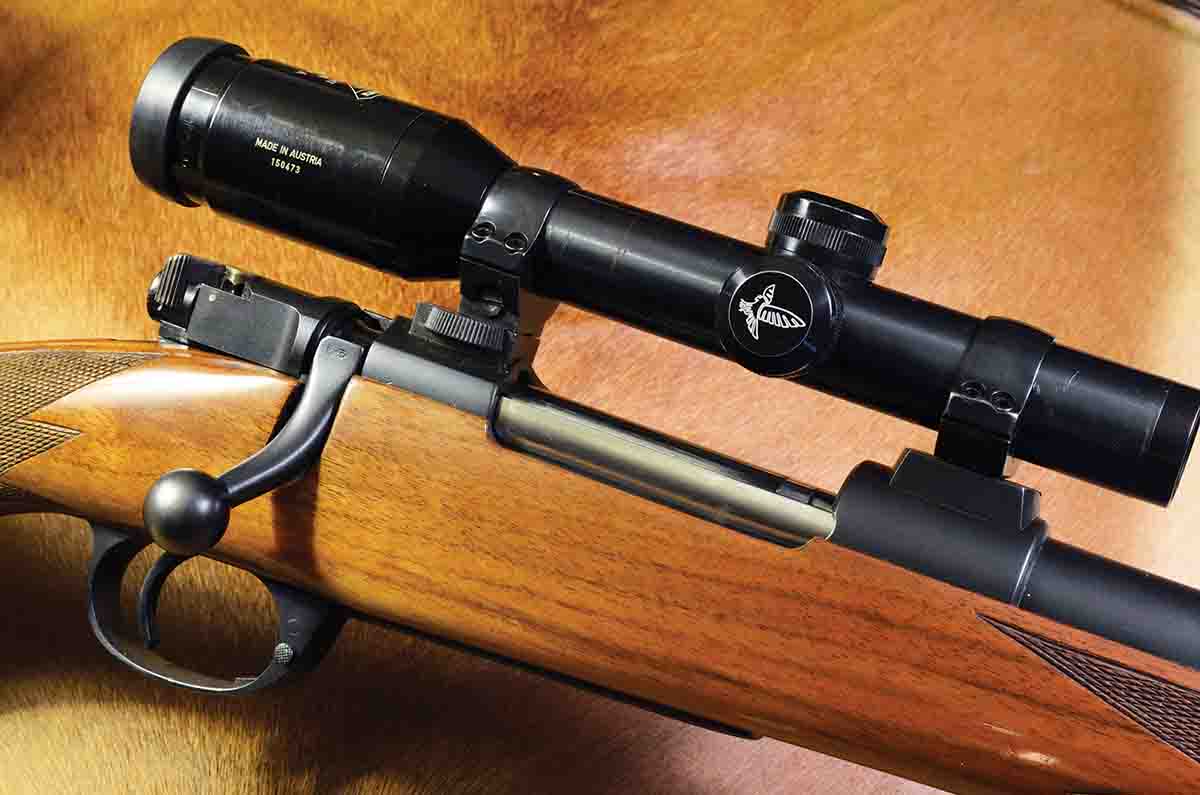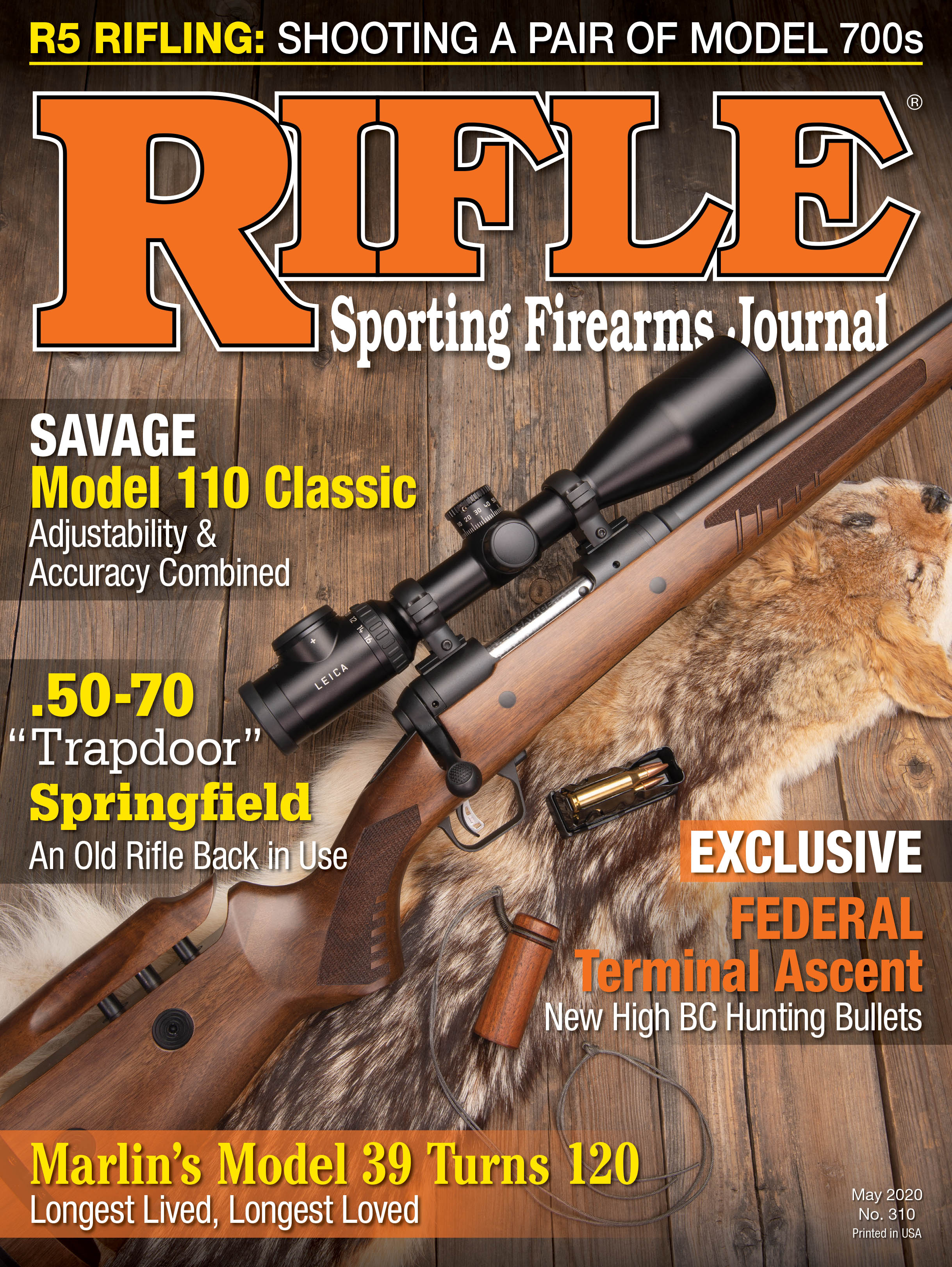Walnut Hill
The Education of a Rifleman II
column By: Terry Wieland | May, 20

Tucked away inside the cloud of regrets, however, there was a silver lining of newfound wisdom to apply to the rebuilding of my collection. In the course of hunting on several continents with half a dozen different rifles, I’d learned a few things. For one, I didn’t want to hunt anything henceforth with a rifle that did not have a three-position safety, like the Model 70. I not only wanted the striker blocked, I wanted the bolt locked closed as well.
Much as I admire the .257 and .300 Weatherby cartridges, I’d played with those enough and found myself leaning toward my youthful inamorata, the .30-06. Dakota Arms was making its mark with the Dakota 76 action, and I acquired one in its plainest grade. It became my standard hunting rifle through the 1990s. With a 23-inch barrel, loaded with 165-grain Trophy Bonded Bear Claws (the pre-Federal originals), I hunted in Africa and North America, from Ungava Bay in the north to deepest Natal in the south. With that rifle, I took my first Ontario whitetail, my first elk and a couple of caribou, among a raft of African game. It confirmed my belief that the .30-06, a venerable cartridge by any standard, is still our best all-around chambering.
When I returned from Africa in 1990, I’d also decided I needed a dedicated Cape buffalo rifle. Around the time the Dakota came into my life, I turned over an FN Supreme action to my German gunmaker Siegfried Trillus and requested he build a .450 Ackley. About 18 months later I collected it, stocked with a piece of American black walnut from a tree Siegfried cut down, sawed up and carved to shape himself. It was fitted with German claw mounts and a Swarovski 1.5x steel-tube scope accompanied by rugged German-made open sights.
This particular rifle, 25 years later and after several trips to Africa, is still the finest bolt-action dangerous-game rifle I have ever handled. We put an after-market bolt shroud on it, with a three-position safety, to meet my demands in that regard. I also made the error of having it Mag-na-ported, but only to keep barrel jump to a minimum, not a full-blown muzzle brake. That was another lesson I learned on the first safari in Africa while shooting an early .416 Weatherby. With the brake on, the noise was deafening; with it off, point of impact changed drastically. I came out of two encounters with two Cape buffalo alive but educated. This was fortunate in another way, because by about 2004 many safari companies were disallowing rifles with muzzle brakes because their trackers were going deaf. The Mag-na-port’s four discreet slots, cut near the muzzle, do not attract attention and noise levels are okay.
The Dakota .30-06 and I parted company after an outside investor took over the company and proceeded to run it and its reputation into bankruptcy, and I no longer wanted to be seen with it. Initially, it was replaced by a Schultz & Larsen Model 65DL in 7x61 Sharpe & Hart. This was a nod to childhood passion, finally requited after 40 years. By this time, Siegfried was dead and Edwin von Atzigen, his successor as my favorite riflesmith, restored the rifle and I hunted with it in the Yukon, then a month later in South Africa. It’s beautifully made and beautifully accurate, but ammunition is a headache, and guess what? I concluded that it would not do anything a lighter, shorter-barreled .30-06 would not do just about as well – not in any meaningful way.
By and large, that is my feeling about all the vaunted 7mm magnums, at least until you get up to such overwrought creations as the 7mm STW, where size, weight, noise, recoil and general awkwardness present a whole new set of unwelcome problems.
Going the other way, I’ve had a soft spot for the mid-sized 6.5s for the better part of 40 years and have owned and hunted, generally successfully, with several. My favorite, still, is the 6.5x55, and I don’t see enough difference between it and the 6.5 Creedmoor to cause me to discard it. I confess to having an iconoclastic bent, however, or what some people see as a congenital need to be always out of step, so as the popularity of 6.5s has ballooned out of all proportion, I find myself with an increasing reluctance to own one. (The exception is the 6.5x54 Mannlicher-Schönauer. There are two superb rifles on the rack, and they are going nowhere.)
As the 6.5mm-mania ballooned, I found myself espousing the .270 Winchester on the one hand, and on the other the sweet old .250-3000. Be honest now: What can a 6.5 Creedmoor do that the .270 Winchester can’t do just as well or better, assuming comparable bullets? Not much.

As for the .250-3000, it’s a cartridge that deserves vastly better than it’s got. Granted, it was the darling a full century ago, and 100 years is a long time to maintain a reputation – but then, the .30-06 is even older. The Savage 99, good though it is, never really got the most out of the .250-3000, and when a nice but anonymous custom rifle on a Mauser action came my way, I grabbed it. I’ve shot only one animal with it, an aoudad in West Texas, up a steep slope at 285 yards. One shot in the heart, a brief dash and a dead aoudad. Its mount is perched on the wall, and it looks very distinguished.
About a year later, I chanced across another custom rifle for sale: an Al Biesen .270 Winchester built in the 1980s on an FN Deluxe action. The seller didn’t know what he had, and even misspelled “Biesen” in his ad. I grabbed it for what I then considered low priced, and now consider it the bargain of a lifetime. Of course, used custom bolt actions are not the hottest ticket in town, auction-wise, but this is a genuine Al Biesen! Before someone asks, I paid $2,700 for it – a fraction of the price of a new custom creation and vastly better than any factory product. If any rifle has replaced my old Dakota .30-06, it’s this one, to the tune of four whitetails, a Persian red sheep and a blackbuck.
Another rifle that should be mentioned is a Kenny Jarrett .257 Weatherby on a Model 70 Classic (pre-64-style) action in 1996. I have hunted with it once (pronghorn in Montana), and it shoots as well as one would expect from a Jarrett. It and the aforementioned 7x61 S&H will trade blows at 300 yards, one triumphing one day, the other the next. Both are very effective and fun to shoot, but neither is as compact, light and handy as either the Biesen .270 or the Mauser-actioned .250-3000.
What rifle would I keep if limited to one? The answer, somewhat reluctantly, would be the Biesen .270. If allowed two, the second would be Siegfried’s .450 Ackley, and the third would be a Savage 99 circa 1922 with open sights, a 22-inch barrel and straight stock in .250-3000. That one is possibly the best deer-stalking woods rifle ever created. Fortunately for us all, we are not limited to one or two or three rifles, but deciding which to keep is an interesting exercise.


